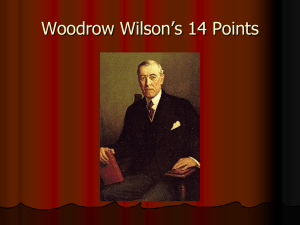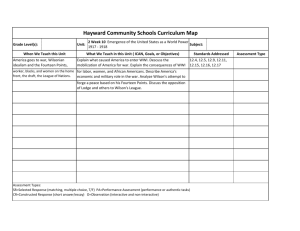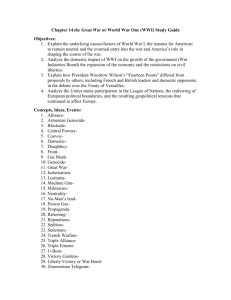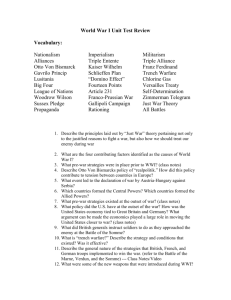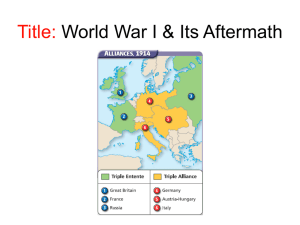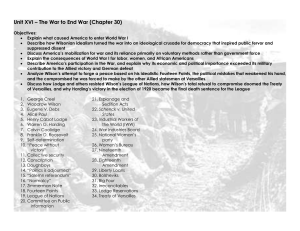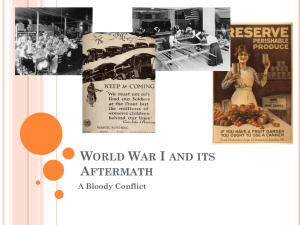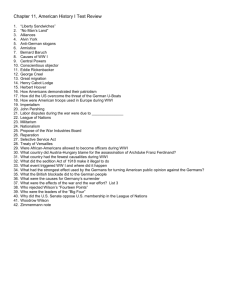BELL QUIZ: USE PAGES 711-717
advertisement
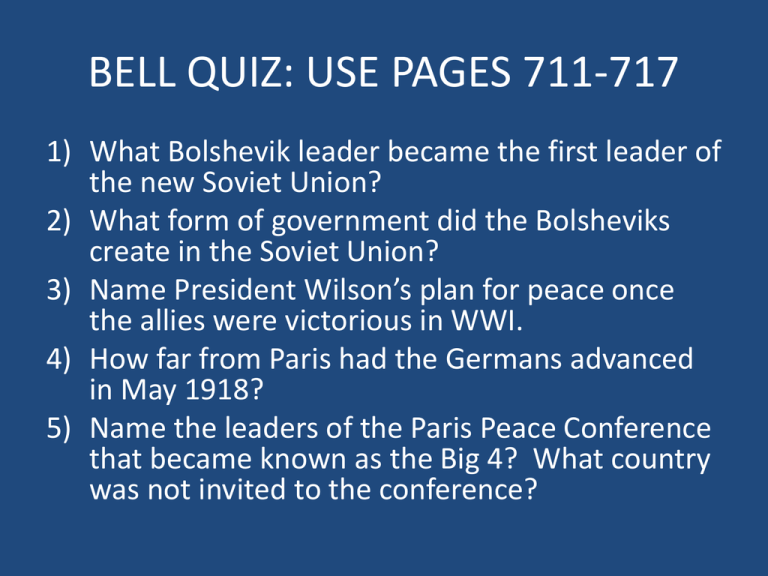
BELL QUIZ: USE PAGES 711-717 1) What Bolshevik leader became the first leader of the new Soviet Union? 2) What form of government did the Bolsheviks create in the Soviet Union? 3) Name President Wilson’s plan for peace once the allies were victorious in WWI. 4) How far from Paris had the Germans advanced in May 1918? 5) Name the leaders of the Paris Peace Conference that became known as the Big 4? What country was not invited to the conference? BELL QUIZ ANSWERS 1) 2) 3) 4) 5) Vladimir Lenin Communism 14 Points 37 Miles Woodrow Wilson (U.S.), David Lloyd George (Britain), Georges Clemenceau (France), Vittorio Orlando (Italy). Russia was not invited to attend cause they had quit the war and were fighting a civil war. THE BOLSHEVIK REVOLUTION • Vladimir Lenin leads the Bolshevik party to victory in the Russian Revolution. • Slogan=peace, bread, and land. • Czar Nicholas II is executed. • Russia changes its name to the Soviet Union and becomes communist. • Russia quits WWI by signing a peace treaty with Germany in March 1918. What is Communism? • Theory: A) The Social class with the economic power also had social and political power. B) There are 2 classes of people in every society: The “Haves” and the “Have-Nots”. Capitalists (Haves): own capital-land, money, and machinery. Workers: (Have-Nots): own only their labor. Communism • In 1919 Vladimir Lenin led the successful Bolshevik Revolution in Russia, installing communism. • Communism: A) economic and political system based on a 1 party government ruled by a dictatorship. B) Private Property is confiscated and turned over to the state to equalize power and wealth. C) Government owns all factories and businesses, controlling production and prices. You Tube Video • Communism Explained Temp File for Marxim Lesson (Communism Explained) • http://www.youtube.com/watch?v=0d4EkeBd 1VE&safety_mode=true&persist_safety_mode =1&safe=active Communism Explained YouTube Video Questions 1. How is wealth distributed in communist societies? 2. What type of leaders are usually in charge of communist governments? 3. How does capitalism exploit the proletariat (workers)? 4. According to the Communist Manifesto how far would communism spread? 5. In communist societies who controls the entire economy? 6. What is socialism? BELL QUIZ: USE PAGES 398-403 1. Name 12 countries that were created in Europe and the Middle East after WWI. (Use map on page 400) 2. Why did the U.S. senate not ratify the Treaty of Versailles and join the League of Nations? 3. Name the leaders of the Paris Peace Conference that became known as the Big 4? 4. Why was Germany upset with the Treaty of Versailles? 5. Why was Russia not invited to attend the Treaty of Versailles? BELL QUIZ ANSWERS 1. Europe: Yugoslavia, Czechoslovakia, Poland, Lithuania, Latvia, Estonia, and Finland. Middle East: Syria, Iraq, Lebanon, Palestine and Jordan. 2. Americans feared that the League of Nations would drag America into wars that did not concern them. 3. Woodrow Wilson (U.S.), David Lloyd George (Britain), Georges Clemenceau (France), Vittorio Orlando (Italy). 4. Germany was forced to sign the “War-Guilt Clause”, pay $32 billion in war reparations, relinquish their colonies in the Pacific Ocean, and reduce their military to a very small number. 5. Russia had quit the war in 1917 and went home to deal with the Bolshevik Revolution (Communist Revolution). WILSON’S 14 POINTS • U.S. President Woodrow Wilson’s 14 points=plan for world peace. • Points 1-5: Issues that must be addressed to prevent future wars (no secret alliances, reduction in military #’s, etc). • Points 6-13: European boundary changes. • Point 14; League of Nations. DEFEAT OF THE CENTRAL POWERS 1) After Russia quits the war Germany pulls all their troops from the Eastern front and moves them to the western front in an offensive against France. 2) Germany gets to within 37 miles from Paris. 3) The U.S. enters the war in May 1918 and sends troops to France to drive the Germans back. 4) Bulgaria, the Ottoman Empire (Turkey), and Austria-Hungary all surrender. 5) Germany signs an armistice in November 1918 when Germany’s soldiers mutiny and refuse to fight due to fatigue and hunger. MILITARY LOSSES IN WWI 1) 2) 3) 4) 5) 6) 8.5 total million soldiers killed. 21 million wounded. Germany had 1.8 million soldiers killed. 1.5 million Russians killed. France had 1.4 million killed. Austria-Hungary and Great Britain lost 1 million. 7) The U.S. had 110,000 casualties in just 10 months of fighting. 8) Cost of war=$300 billion. THE PARIS PEACE CONFERENCE 1) In January 1919 the allies met in Versailles, France to dictate the terms of peace. 2) The Big 4 dominated the conference: Woodrow Wilson (U.S.), David Lloyd George (Britain), Vittorio Orlando (Italy), and Georges Clemenceau (France). 3) Russia is not invited to attend because they had quit the war in March 1918 and were currently fighting the Russian civil war (Communist Revolution). Russia is way upset! 4) Germany will be blamed for staring WWI and will pay the heaviest price. TREATY OF VERSAILLES 1) Germany forced to sign the “war guilt clause”, making them admit guilt to starting the war. • Must pay $32 billion dollars in war reparations or damages (equal to $393.6 billion U.S. dollars in 2015). • Germany could have no military draft; a maximum army of 10,000 soldiers; could not build artillery, tanks, airplanes or submarines; all German colonies were taken away. TREATY OF VERSAILLES 2) LEAGUE OF NATIONS * Goals: promote international cooperation and to keep peace among nations by settling disputes and reducing armaments. * Members of the League agreed not to go to war over any disputes. Instead they would submit a dispute to the world Court and try to arrive at a compromise. * If a nation broke this agreement, the League would impose penalties such as breaking diplomatic relations or impose economic sanctions (blocking trade). * Military force would be used only as a last resort. START OF THE LEAGUE • The U.S. senate voted against joining the League of Nations even though it President Wilson’s idea. • Why? The U.S. did not want to get dragged into a war over issues that did not concern them. • 42 Nations joined the League in 1920. • Germany joined in 1926. The Soviet Union joined in 1934. • By 1940 there were 59 nations in the League of Nations. • The League of Nations becomes the United Nations after WWII. Chapter 11 Handout

